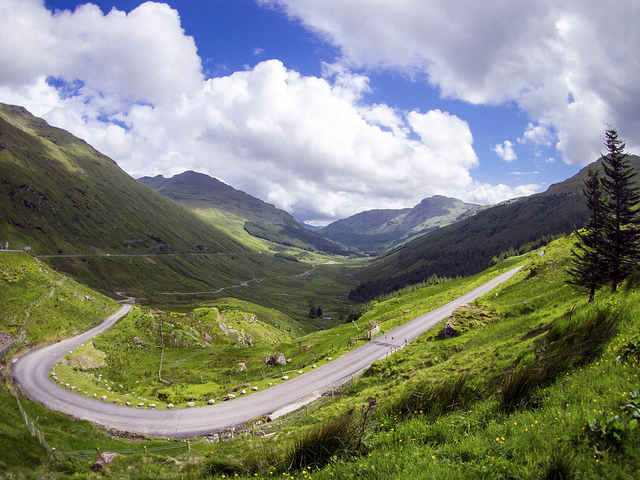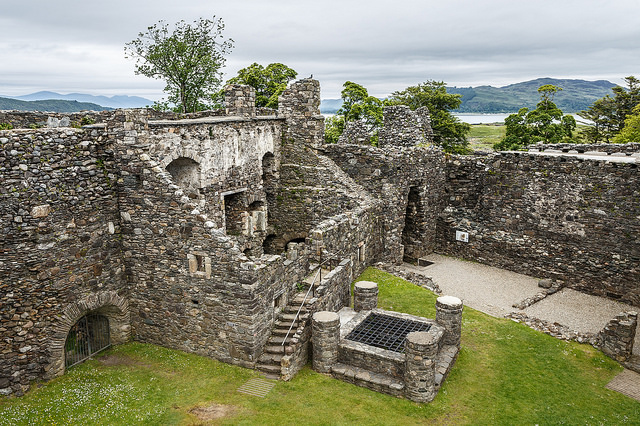America has the Pacific Coast Highway and Route 66. Norway has the Atlantic Highway. But Scotland has no fewer than 12 National Tourist Routes to showcase her beauties. If you’re not in a hurry – and why would you be, with such spectacular scenery around? – they’re worth exploring. The Argyll Coastal Route takes a triangular (and not always coastal) path around one of Scotland’s loveliest regions.
The bonnie banks
You start at Tarbet, on the bonnie and famous banks of Loch Lomond, go down to Lochgilphead and then up through Oban to Ballachulish. It’s definitely not the direct route – in fact it looks somewhat like the outline of India and is 150 miles long – but you’ll see more country and less traffic than on the main road.
The A82 road up the west side of Loch Lomond carries a lot of traffic and it’s a relief to leave it at Tarbet for the quieter A83 to Arrochar and the equally beautiful Loch Long. Loch Lomond is a fresh-water lake, but Loch Long is one of the many fjord-like sea lochs on Scotland’s west coast.
Arrochar sits at the foot of several Munros, hills over 3,ooo feet (914 metres) high, which are popular with walkers and climbers. People who attempt to climb all of them are known as “Munro baggers”. If you fancy a spot of Munro bagging, the Walk Highlands website has lots of useful information on the most popular walking routes, and covers easy, short walks right through to multi-day treks.

From Arrochar you head for Ardgartan, which has way-marked walking and bike trails through the forestry. After Ardgartan you leave the sea for a while, heading through the hilly wooded Glen Croe. The stop at the top of the pass is called the Rest and Be Thankful: horse-drawn vehicles and even early motorised ones would have found the climb very hard going.
If you stop to rest and give thanks, look out for the stone that commemorates the “”Military Road Repaired by 93rd Regt 1768 Transferred to Commissioners for Highland Roads and Bridges in the year 1814”. This was one of several military roads built across Scotland in the 1700s, originally to keep the Jacobites under control.
The longest loch
It’s not quite downhill all the way from here to Loch Fyne, but it’s not far off it. The 40-mile long Loch Fyne is one of the longest sea-lochs in Scotland, if not the longest. It’s famous for its kippers (smoked herrings) and other sea-food. Just before you reach it, Ardkinglas Woodland Garden at Cairndow is worth a visit. From Cairndow you travel right round the head of the loch, with spectacular views down the length of it.
Many streams run into the loch, so you cross a whole series of bridges on the way to Inverurie. Inverurie Castle, home of the Dukes of Argyll, is open to the public, as is the old town Jail. The town is worth a walk round, too, with some handsome architecture and excellent tea shops.
A little further down the loch is Furnace, once the site of an iron foundry. There’s nothing left of it to see, and the road continues to Lochgilphead along the side of the loch. There are plenty of places along the way to stop and enjoy the view, have a cup of tea or just let traffic overtake you.
A little south of Lochgilphead is Ardrishaig. It’s worth the slight detour to see the Crinan Canal, which cuts through the Mull of Kintyre from here to save boats the long journey round it. It’s a very pretty canal to walk along – all 9 miles of it!
Mull of Kintyre
The Tourist Route also crosses the Mull of Kintyre, running north-west from Lochgilphead up the A816. If you’re a fan of prehistory, stop at Dunadd, historic coronation site of the Kings of Dalriada, and at Kilmartin Glen, where you can find standing stones and stone circles from even earlier.
Carnasserie Castle, a mile or so further on, is a fine 16th Century ruin in the care of Historic Environment Scotland. It was once the home of the first Protestant Bishop of the Isles and has magnificent views back to Kilmartin Glen; in fact you can see some of the standing stones from the castle tower.
There’s little view of the sea for many miles on this stretch of the road – just an occasional glimpse to remind you that it’s meant to be a coastal route. But once you’ve passed the signs to the yacht harbour at Craobh Haven you’re back at the waterside, following the southern edge of Loch Melfort to Kilmelford before heading back inland.
If you time it right, you may be lucky enough to watch the sun set over Seil and Luing, two islands so close to the mainland they hardly count as islands. You can reach Seil by the grandiosely-named but tiny Atlantic Bridge, properly called the Clachan Bridge. It dates from 1792 (though it’s been altered since then to stop sheep jumping off it) and joins the island to the mainland over a river-wide stretch of sea.
There’s a ferry from Seil to Luing, which used to be famous for its slate mines. When the sea flooded them all the equipment was left behind and they were abandoned.
If you want to explore the coast around here, you’re best to park your motorhome and use a bike. The tiny roads are not really designed for large motor vehicles (though plenty use them) and the locals will be grateful to you.
O Ban: the small bay
From Kilninver the road heads inland along the southern shore of Loch Feochan before crossing rugged, rocky country on its way to Oban. The island of Kerrera appears to block Oban Bay, but the town is in fact a busy ferry port, with regular sailings to Mull and the Inner and Outer Hebrides.
Oban is an important centre for scuba diving, for both recreational and professional divers. Another big attraction is the “hollow mountain”, Ben Cruachan, which houses a hydro-electric power station one kilometre underground. The local distillery is also worth a visit – but be aware that Scotland’s drink-driving laws are some of the toughest in Europe!

Just the other side of Oban, a visit to Dunstaffnage Castle is worth the slight detour before you turn onto the A828. Crossing the Connel Bridge, over the Falls of Lora at the neck of Loch Etive, the road continues across the Benderloch peninsula to Loch Creran, a lovely sea-loch almost cut off from the sea by the island of Eriska.
You can either cross the loch via the Creagan bridge or take the pretty but narrow road that travels all the way round it. If you want to bag a few Munros, the longer road gives you access to three.
The last leg
From Creagan you cross the Strath of Appin to Portnacroish – look out for the photogenic Castle Stalker lurking on its island at the mouth of Loch Laich. You then follow the shores of Loch Linnhe north-east all the way to Ballachulish, with a slight detour inland between Duror and Kentallen.
This is a spectacular road for photographers. Cuil Bay, just before you reach Duror, has a glorious sandy beach that features in Robert Louis Stevenson’s adventure story “Kidnapped”.
At Ballachulish Bridge the A828 joins the A82. Turn right to reach Ballachulish itself, another old slate-mining town, which lies at the foot of a Munro and offers plenty of excellent forest walks. Turn onto the road that circles Loch Leven to enjoy your journey a little while longer. The road was built by first World War prisoners of war to reach an aluminium smelter (no longer there) at Kinlochleven.
If you’re heading south from here you can return across the Ballachulish Bridge on the A82 towards Perth, Glasgow and Edinburgh via Glen Coe. The road north, whether you cross the bridge or go round the loch, takes you to Fort William, Loch Ness and Inverness.
But for the Argyll National Tourist Route, Ballachulish is the end of the road. If you’ve enjoyed the trip, do let us know!